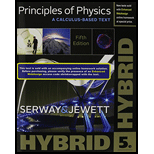
(a)
The charge on the capacitor
(a)
Answer to Problem 69P
The charge on the capacitor
Explanation of Solution

The switch is closed in the electric circuit and the current exists in a simple series circuit as shown in figure
Write the expression for the power delivered to the resistor.
Here,
Use equation (I) to solve for
Write the expression for the potential difference across the resistor
Here,
Write the expression for the charge on the capacitor
Here,
Conclusion:
Substitute
Substitute
Substitute
Therefore, the charge on the capacitor
(b)
The amount of charge on the capacitor
(b)
Answer to Problem 69P
The amount of charge on the capacitor
Explanation of Solution

Consider the switch is closed to find the emf of the battery and the charge in the capacitor
Write the expression for the potential difference across
Write the expression for the charge on the capacitor
Write the expression for the emf of the battery.
Here,
Write the expression for
Use equation (VIII) in (VII) to solve for
Here,
After the switch is opened, no current exists. The potential difference across each resistor is zero. The emf of the battery appears across both capacitors.
Write the expression for the new charge on the
Write the expression for the amount of the charge on the capacitor is changed
Here,
Conclusion:
Substitute
Substitute
Substitute
Substitute
Substitute
Therefore, the amount of charge on the capacitor
Want to see more full solutions like this?
Chapter 21 Solutions
Principles of Physics: A Calculus-Based Text, Hybrid (with Enhanced WebAssign Printed Access Card)
- Lab 8 Part 3 PHET Wave Interface simulation. I am having trouble with this part of the lab.arrow_forwardMick and Rick are twins born on Earth in the year 2175. Rick grows up to be an Earth-bound robotics technician while Mick becomes an intergalactic astronaut. Mick leaves the Earth on his first space mission in the year 2200 and travels, according to his clock, for 10 years at a speed of 0.75c. Unfortunately, at this point in his journey, the structure of his ship undergoes mechanical breakdown and the ship explodes. How old is Rick when his brother dies?arrow_forwardHi, I have canceled, why did you charge me again?arrow_forward
 Principles of Physics: A Calculus-Based TextPhysicsISBN:9781133104261Author:Raymond A. Serway, John W. JewettPublisher:Cengage Learning
Principles of Physics: A Calculus-Based TextPhysicsISBN:9781133104261Author:Raymond A. Serway, John W. JewettPublisher:Cengage Learning College PhysicsPhysicsISBN:9781938168000Author:Paul Peter Urone, Roger HinrichsPublisher:OpenStax College
College PhysicsPhysicsISBN:9781938168000Author:Paul Peter Urone, Roger HinrichsPublisher:OpenStax College College PhysicsPhysicsISBN:9781305952300Author:Raymond A. Serway, Chris VuillePublisher:Cengage Learning
College PhysicsPhysicsISBN:9781305952300Author:Raymond A. Serway, Chris VuillePublisher:Cengage Learning College PhysicsPhysicsISBN:9781285737027Author:Raymond A. Serway, Chris VuillePublisher:Cengage Learning
College PhysicsPhysicsISBN:9781285737027Author:Raymond A. Serway, Chris VuillePublisher:Cengage Learning Physics for Scientists and EngineersPhysicsISBN:9781337553278Author:Raymond A. Serway, John W. JewettPublisher:Cengage Learning
Physics for Scientists and EngineersPhysicsISBN:9781337553278Author:Raymond A. Serway, John W. JewettPublisher:Cengage Learning Physics for Scientists and Engineers with Modern ...PhysicsISBN:9781337553292Author:Raymond A. Serway, John W. JewettPublisher:Cengage Learning
Physics for Scientists and Engineers with Modern ...PhysicsISBN:9781337553292Author:Raymond A. Serway, John W. JewettPublisher:Cengage Learning





